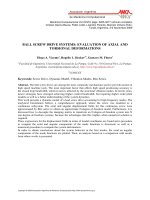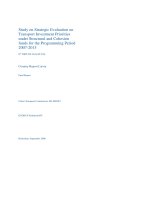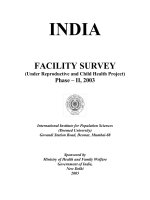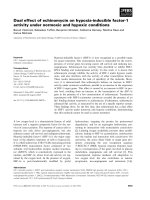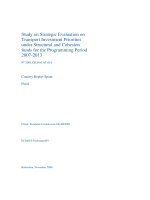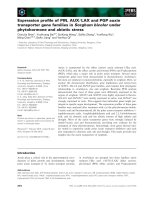FRP confined capsule shaped columns under axial and lateral loading
Bạn đang xem bản rút gọn của tài liệu. Xem và tải ngay bản đầy đủ của tài liệu tại đây (5.12 MB, 226 trang )
FRP-CONFINED CAPSULE-SHAPED COLUMNS
UNDER AXIAL AND LATERAL LOADINGS
TAMALI BHOWMIK
NATIONAL UNIVERSITY OF SINGAPORE
2011
FRP-CONFINED CAPSULE-SHAPED COLUMNS
UNDER AXIAL AND LATERAL LOADINGS
TAMALI BHOWMIK
(B. Eng., Jadavpur University)
A THESIS SUBMITTED
FOR THE DEGREE OF DOCTOR OF PHILOSOPHY
DEPARTMENT OF CIVIL & ENVIRONMENTAL ENGINEERING
NATIONAL UNIVERSITY OF SINGAPORE
2011
ACKNOWLEDGEMENTS
This thesis represents the hard work of many individuals to whom I could never
express the extent of my gratitude. First and foremost, I express my sincere and
profound gratitude to my supervisors, Prof. Tan Kiang Hwee and Prof. Balendra
for their erudite and invaluable guidance throughout the study. Their analytical
and methodical way of working has inspired me and under their guidance I have
learned a lot. Prof. Tan and Prof. Balendra’s assistance and valuable comments
during the preparation of this thesis are also appreciated.
I would also like to acknowledge NUS for providing all necessary
financial and academic support without which my Ph.D. would have been a
distinct dream.
Grateful thanks are extended to the staffs of the Structural Engineering
Laboratory, National University of Singapore for their assistance rendered
throughout the study. Mr. Koh Yian Kheng, Mr. Choo Peng Kin, Mr. Ishak Bin
A Rahman, Mr. Ang Beng Oon, Mr. Yip Kwok Keong, Mr Kamsan Bin
Rasman, Mr Ow Weng Moon and Mr Wong Kah Wai, Stanley had been
extremely helpful during the experiments. Special acknowledgements are given
to Mr. Choo Peng Kin, Mr. Koh Yian Kheng and Mr. Ishak Bin A Rahman who
had assisted and guided me tremendously from the fabrication up to the testing
of the specimens. Special thanks are given to Madam Annie Tan, Mr. Ang Beng
Oon and Mr. Yip Kwok Keong for their kind help whenever I need. Last but not
the least, I sincerely thank our laboratory manager Mr Lim Huay Bak for his
invaluable guidance throughout the experiments.
i
The friendship and collaboration with a number of my fellow graduate
students has also been invaluable. Special thanks are given to Du Hongjian,
Aziz Ahmed and Patria Kusumaningrum for their help and great
encouragement.
Words are not enough to thank my family for the support they have
given me during this long and sometimes difficult journey. I can only grab this
opportunity to remember their endless support and unconditioned love during
my pursuit of higher education.
ii
TABLE OF CONTENTS
Acknowledgements i
Table of Contents iii
Summary viii
List of Tables x
List of Figures xii
List of Symbols xviii
CHAPTER 1: INTRODUCTION
1.1 Background 1
1.2 Retrofitting by Fiber reinforced polymer systems 2
1.3 FRP-confined concrete columns 3
1.3.1 Reprofiling of the rectangular sections 4
1.4 Research objectives 5
1.5 Organization of the thesis 6
CHAPTER 2: LITERATURE REVIEW
2.1 General 10
2.2 FRP-confined columns under axial loading 11
2.2.1 Effect of FRP amount and concrete strength 12
2.2.2 Effect of aspect ratio and shape of column 13
2.2.3 FRP-confinement models 14
2.2.4 Stress-strain models for FRP- confined columns 22
2.3 FRP- confined columns under lateral loading 23
iii
2.3.1 Types of column failures during earthquake 24
2.3.2 Seismic retrofitting by CFRP confinement 26
2.4 Summary 28
CHAPTER 3: ANALYSIS AND TESTING UNDER AXIAL
LOADING
3.1 Proposed Confinement Models 40
3.1.1 Model “A” 40
3.1.2 Model “B” 44
3.2 Test Program 48
3.3 Material Properties 49
3.4 Test Preparation 50
3.4.1 Preparation of column specimens 50
3.4.2 Installation of Carbon FRP Systems 51
3.5 Test Instrumentation, Setup and Test Procedure 51
3.6 Test Results and Discussion 52
3.6.1 Overall Behavior 52
3.6.1.1 Series I columns 52
3.6.1.2 Series II columns 54
3.6.2 Failure characteristics 55
3.6.3 Stress-Strain Response 56
3.6.3.1 Series I columns 56
3.6.3.2 Series II columns 58
3.7 Comparison with predictions of proposed confinement models 59
iv
3.8 Summary 60
CHAPTER 4: ANALYSIS AND TESTING UNDER LATERAL
LOADING
4.1 Introduction 83
4.2 Theoretical Considerations 84
4.2.1 Ultimate lateral load capacity 84
4.2.1.1 Shear Capacity 84
4.2.1.2 Flexural Capacity 86
4.2.2 Inelastic displacement 90
4.3 Numerical Modeling in SEISMOSTRUCT 94
4.3.1 Overview of SEISMOSTRUCT 94
4.3.2 FEA modeling 95
4.3.3 Limitation of SEISMOSTRUCT 98
4.4 Test program 98
4.5 Material properties 100
4.5.1 Internal steel reinforcement 100
4.5.2 Concrete 101
4.5.3 FRP system 101
4.6 Fabrication of specimens 101
4.7 Test setup, instrumentation and procedure 103
4.7.1 Instrumentation 104
4.7.1.1 Strain Gauges 104
4.7.1.2 Displacement transducers 104
4.7.2 Test procedure 105
v
4.8 Test results and discussions 106
4.8.1 Behavior and mode of failure 106
4.8.1.1 Pushover tests 106
4.8.1.2 Cyclic test 108
4.8.2 Lateral load-displacement response 109
4.8.3 Effect of reprofiling 111
4.8.4 Effect of CFRP systems 112
4.8.5 Moment-curvature response 113
4.9 Comparison of theoretical, numerical and experimental results 114
4.10 Summary 115
CHAPTER 5: CASE STUDIES
5.1 Introduction 146
5.2 Modeling of FRP-confined column 147
5.2.1 Calibration of FEA model 150
5.3 Case study 1: Sub-frame of a 4-storey residential building 150
5.3.1 FEA modeling of sub-frame 151
5.3.2 Member properties 152
5.3.3Boundary conditions 153
5.3.4 Vertical and lateral loads 153
5.3.5 Failure identification 155
5.3.6 FEA results and discussion 155
5.4 Case study 2: Northridge bridge pier 157
5.4.1 Case study 2(a): Pier with section aspect ratio of 3.0 157
vi
5.4.1.1 FEA modeling of pier 157
5.4.1.2 Failure identification 158
5.4.1.3 Pushover analysis 160
5.4.1.4 Seismic demand and capacity 162
5.4.2 Case study 2(b): Pier with section aspect ratio of 4.4 168
5.4.2.1 Pushover analysis 168
5.4.2.2 Evaluation of seismic adequacy 169
5.5 Summary 170
CHAPTER 6: CONCLUSIONS AND RECOMMENDATIONS
6.1Conclusions 194
6.2 Recommendations for further research 197
REFERENCES
198
vii
SUMMARY
The application of externally bonded fiber reinforced polymer (FRP)
composites has achieved enormous popularity in recent times for the
strengthening and repairing of old concrete bridges and buildings. Specifically,
concrete columns and bridge piers in existing structures, which generally have
inadequate transverse reinforcement as per old design codes, are vulnerable to
seismic attacks and thus they need to be strengthened to enhance their strength
and ductility. The externally bonded transverse FRP systems provide additional
confinement which lead to an increase in the compressive strength, shear
capacity and ductility of the confined columns and piers.
Previous studies on FRP-confined columns indicated that the
confinement effect is most significant in circular column sections and, to some
extent, in square sections rather than in rectangular sections with large aspect
ratios. But, in reality, many building columns and bridge piers are rectangular in
shape with an aspect ratio of more than 1.5, and as large as 7, which may well
be termed “wall-like” columns. To enhance the confinement effect from FRP
systems, reprofiling of rectangular columns is proposed herein by adding two
circular concrete segments at the shorter sides and thus forming a capsule-
shaped section before applying the transverse FRP reinforcement.
The current thesis presents the details and results of a study on the FRP-
confined capsule-shaped columns subjected to axial and lateral loads. The main
parameters of the study were the effect of section geometry and the number of
ply of transverse FRP sheets.
viii
The axial load tests showed significant enhancement in axial load
capacities of capsule-shaped columns. The proposed confinement models are
valid for circular, square, rectangular and capsule-shaped sections and they
showed reasonable accuracy to predict the axial load capacity of tested columns.
The pushover load tests on FRP-confined rectangular and capsule-
shaped columns showed the effectiveness of transversely bonded FRP systems
to prevent the shear failure and to enhance ductility significantly. The predicted
load-displacement profiles matched very well with the experimental
observations. The stiffness and strength degradations in cyclic load test of FRP-
confined column were also prevented by the externally bonded FRP
reinforcement.
A finite element model of FRP-confined capsule-shaped columns was
developed and calibrated using the cyclic response obtained from the test and
hysteresis parameters were determined. Two case studies consisting of FE
analysis of a building frame and a bridge pier were illustrated. In both studies,
FRP confinement prevented the shear failure and enhanced the drift ratio of the
structure. The seismic adequacy of FRP-confined pier was checked against the
seismic demand for Northridge earthquake.
Keywords: Fiber reinforced polymer, aspect ratio, capsule-shaped columns,
carbon FRP, confinement, axial load capacity, ductility, seismic demand
ix
LIST OF TABLES
CHAPTER 2
Table 2.1 Confinement models for FRP confined circular column
Table 2.2 Confinement models for FRP confined rectangular column
CHAPTER 3
Table 3.1 Database used for linear regression analysis
Table 3.2 Properties of carbon FRP sheets
Table 3.3 Mix proportion of resin
Table 3.4a Test results of Series I columns
Table 3.4b Test results of Series II columns
Table 3.5a Comparison of predicted and observed axial load capacity for
Series I columns
Table 3.5b Comparison of predicted and observed axial load capacity for
Series II columns
CHAPTER 4
Table 4.1 Theoretical predictions of lateral load capacity and displacement for
test columns
Table 4.2
Properties of steel reinforcement
Table 4.3 Test results
Table 4.4 Comparison of observed ultimate lateral load capacity with theoretical
and numerical predictions
x
CHAPTER 5
Table 5.1 Elastic section properties of column LC-0.19-2
Table 5.2 Parameters of yield surface for column LC-0.19-2
Table 5.3 Dimensions and reinforcement details of 4-storey frame
Table 5.4 Section properties of members of 4-storey frame
Table 5.5 Input values to define the yield surface of sections in 4-storey frame
Table 5.5(a) Input values to define the yield surface of FRP-confined elements
Table 5.6 Elastic section properties of pier
Table 5.7 Input values to define the yield surface of pier
xi
LIST OF FIGURES
CHAPTER 1
Figure 1.1 Columns and piers with large aspect ratios
Figure 1.2 Re-profiling of rectangular column
Figure 1.3 Capsule-shaped column
CHAPTER 2
Figure 2.1 Stress-strain profiles for CFRP-confined columns (Chaallal et al.
2003)
Figure 2.2 Strengthening ratios for FRP-confined rectangular columns (Chaallal
et al. 2003)
Figure 2.3 Effect of corner radius on FRP-confined square columns (Al-
Salloum 2007)
Figure 2.4 Stress-strain model of steel - confined concrete (Mander et al. 1988)
Figure 2.5 Rectangular column confined by steel links
Figure 2.6 FRP-confined rectangular column section
Figure 2.7 Confinement models of FRP-confined circular column
Figure 2.8 Variation of strengthening ratio (f ’
cc
/ f ’
co
) with confinement ratio
(f
l
/ f ’
co
) for circular columns (Teng et al. 2002)
Figure 2.9 Equivalent circular column model by Lam and Teng (2003)
Figure 2.10 Stress-strain profile of FRP-confined concrete
Figure 2.11 Stress-strain profiles of FRP-confined square columns (Wang and
Wu 2008)
xii
Figure 2.12 Types of seismic failure of columns during severe earthquakes
CHAPTER 3
Figure 3.1 Confinement model for a capsule-shaped column
Figure 3.2 FRP strain efficiency factor (κ
ε
) vs. section aspect ratio (h/b) for
rectangular columns
Figure 3.3 Proposed Confinement model for rectangular and capsule-shaped
column
Figure 3.4 Effective confinement coefficient k
e
vs. aspect ratio (h/b)
Figure 3.5 Strengthening ratio (f’
cc
/f’
co
) vs. modified confinement ratio (f*
l
/f’
co
)
Figure 3.6 Reinforcement details of columns for Series II columns
Figure 3.7 Geometrical details of test specimens with strain gauge locations
Figure 3.8 A typical CFRP wrapped specimen
Figure 3.9 Typical axial load test set-up
Figure 3.10 Strengthening ratios (f’
cc
/f’
co
) vs. aspect ratios (h/b) for Series I
columns
Figure 3.11 Strengthening ratios (f’
cc
/f’
co
) vs. FRP section area ratios (
ρ
) for
Series I columns
Figure 3.12a Failure pattern of Series I columns with aspect ratio of 2
Figure 3.12b Failure pattern of Series I columns of aspect ratio of 3
Figure 3.12c Failure pattern of Series I columns with aspect ratio 4
Figure 3.12d Close-up view of failure pattern of column PC43
Figure 3.13a Failure pattern of Series II columns with aspect ratio of 3
Figure 3.13b Failure pattern of Series II columns with aspect ratio 4
xiii
Figure 3.14 Stress-strain characteristics of Series I columns
Figure 3.15 Ultimate transverse strains vs. aspect ratio (h/b) relations of Series I
columns
Figure 3.16 Stress-strain characteristics of Series II columns
Figure 3.17 Comparison of proposed models with test results for Series I
columns
Figure 3.18 Comparison of proposed models with test results for Series II
columns
CHAPTER 4
Figure 4.1 Capsule-shaped column
Figure 4.2 Section analysis by method of strain compatibility
Figure 4.3 Inelastic deformation of Column
Figure 4.4 Bilinear approximation of moment-curvature curve
Figure 4.5 Fiber approach in SEISMOSTRUCT
Figure 4.6 Modeling of 2D frame in SEISMOSTRUCT
Figure 4.7 Details of specimens (all dimensions in mm.)
Figure 4.8 Reinforcement details and strain gauge location
Figure 4.9 Stress-strain characteristics of φ13mm deformed steel bars
Figure 4.10 Schematic diagram of test set-up
Figure 4.11 Side elevation of Test Set-up
Figure 4.12 Plan view of Test Set-up
Figure 4.13 Typical test set-up for FRP confined capsule-shaped column
Figure 4.14 Locations of displacement transducers
Figure 4.15 Cyclic loading history
xiv
Figure 4.16 Failure patterns of unconfined columns
Figure 4.17 Failure patterns of CFRP confined columns
Figure 4.18 Lateral load vs. strain from longitudinal reinforcement for
LC-0.19-2
Figure 4.19 Lateral load vs. longitudinal strain from FRP surface for LC-0.19-2
Figure 4.20 Failure patterns of column LC-0.19-2
Figure 4.21 Lateral load-displacement characteristics of columns under
pushover loading
Figure 4.22 Lateral load vs. top displacement characteristics of column
LC-0.19-2
Figure 4.23 Comparison between pushover and cyclic response
Figure 4.24 Effect of section geometry
Figure 4.25 Variation of displacement ductility with numbers of CFRP plies
Figure 4.26 Variation of drift ratio with numbers of CFRP plies
Figure 4.27 Moment-curvature profiles of columns under pushover loading
Figure 4.28 Moment-curvature profile of column L-0.19-2 from pushover and
cyclic test
Figure 4.29 Comparison of theoretical, numerical and experimental results:
Group A columns
Figure 4.30 Comparison of theoretical, numerical and experimental results:
Group B columns
Figure 4.31 Comparison of theoretical, numerical and experimental results:
Group C columns
xv
CHAPTER 5
Figure 5.1 2D frame type element (Carr 2002a)
Figure 5.2 Axial load-moment interaction yield surface
Figure 5.3 Modified Takeda Hysteresis model
Figure 5.4 Comparison between test result and FEA result of LC-0.19-2
Figure 5.5 Cycle by cycle comparison of test result with FEA of LC-0.19-2
Figure 5.6 (a) Plan view of whole building
Figure 5.6 (b) Elevation of selected critical frame
Figure 5.7 Nodes, elements and sections of FEA model of 4-storey frame
Figure 5.8 Total base shear/gravity load (V
b
/W
g
) (%) vs. overall drift ratio (%)
Figure 5.9 Bridge pier failures in Northridge earthquake
Figure 5.10 (a) Cross-section details of Northridge bridge pier
Figure 5.10 (b) Elevation of Northridge bridge pier
Figure 5.11 Finite element model of pier
Figure 5.12 Northridge earthquake ground motion
Figure 5.13 Contribution of axial force (P) to column shear strength
Figure 5.14 Shear force vs. top displacement of Northridge bridge pier
Figure 5.15 Identification of shear failure point of Northridge bridge pier with
section aspect ratio of 3
Figure 5.16 Time history profile of curvature ductility factor for as-built pier
Figure 5.17 Time history profile of shear for as-built pier
Figure 5.18 Time history profile of curvature ductility factor for FRP-confined
pier
Figure 5.19 Time history profile of shear for FRP-confined pier
xvi
Figure 5.20 Seismic demand spectrum (5% damping) for 1994 Northridge
earthquake
Figure 5.21 Derivation of energy dissipated by damping (E
D
)
Figure 5.22 Evaluation of seismic adequacy of Northridge bride pier of aspect
ratio of 3
Figure 5.23 Cross-section details of modified bridge pier
Figure 5.24 Identification of failure points of Northridge bridge pier with
section aspect ratio of 4.4
Figure 5.25 Evaluation of seismic adequacy of Northridge bridge pier with
section aspect ratio of 4.4
xvii
LIST OF SYMBOLS
A Area of column
A
c
Area of confined concrete core
A
s
Area of steel reinforcement in column
a Shear span
a
pi
Maximum spectral acceleration of the capacity spectrum
b Width of the section
c
u
Neutral axis depth at ultimate compressive strain
c
y
Neutral axis depth at yielding
d Effective depth of column
d
b
Diameter of flexural steel reinforcement
d
pi
Maximum spectral displacement of the capacity spectrum
E
c
Modulus of elasticity of concrete
E
D
Energy dissipated by the structure in a single cycle of motion
E
FRP
Elastic modulus of FRP systems
E
so
Maximum strain energy associated with one cycle of motion
f’
c
Cylinder compressive strength
f
’
cc
Maximum confined compressive strength of concrete
f’
c-conf
Cylinder strength of confined column
f
’
co
Unconfined compressive strength of concrete
f’
c-unconf
Cylinder strength of unconfined column
f’
cc
/f’
co
Strengthening ratio
f
FRP
Tensile strength of FRP systems in hoop direction
xviii
f
l
Lateral confining pressure on concrete
f
lx
Lateral confining pressures in horizontal direction
f
ly
Lateral confining pressures in vertical direction
f
y
Yield strength of longitudinal steel
f
uj
Tensile strength of FRP systems
f
yv
Yield stress of steel links
h Depth of the section
h/b Section aspect ratio of the column
k
c
Concrete strength enhancement factor
k
e
Effective confinement coefficient
L Height of the cantilever column
L
p
Plastic hinge length of column
M Flexural moment at failure
M
u
Ultimate moment
M
y
Yield moment
n Number of ply of FRP sheets
P Applied axial load
P
conf
Axial load carrying capacity of confined column
P
o
Nominal axial load capacity of column as per ACI 318-05
P
unconf
Axial load carrying capacity of unconfined column
r Corner radius
s Spacing of steel links
t
FRP
Thickness of a single ply of FRP sheet
u Bond stress
V
c
Concrete and axial load contribution to the total shear capacity
xix
V
s
Shear contribution from transverse steel links
V
p
Shear contribution from transverse FRP confinement
β
0
Hysteretic damping
ε
c
Axial strain of concrete
ε
co
Axial strain in concrete corresponding to f’
co
ε
cu
Ultimate extreme fiber compressive strain
ε
fe
Tensile strain of FRP at failure
ε
fu
Rupture strain of FRP systems
ε
uj
Hoop strain of FRP plies at failure
ε
y
1
st
yield strain of outermost flexural reinforcement bar
ε
u
Rupture strain of steel reinforcement
κ
ε
FRP strain efficiency factor
ρ
FRP section area ratios
ρ
FRP
Volumetric ratio of confining FRP systems
ψ
Curvature of the column section at base
ψ
y
Curvature corresponding to the 1
st
yielding of longitudinal steel
ψ
u
Curvature corresponding to the failure of specimen
xx
CHAPTER 1
INTRODUCTION
1.1 Background
Retrofitting and strengthening of existing concrete structures are the greatest
challenge for modern civil engineers and the needs for strengthening of concrete
structures can be summarized as follows:
(i) Increased live loading: Investigations on some recent structural
failures like Versailles wedding hall disaster in Jerusalem (2001) and De la
Concorde overpass collapse in Canada (2006) revealed that the main reasons
behind the collapse is increased live loads. In the first
case, the live load due to
occupancy during wedding ceremony was typically much greater than the
design load for a roof. The Concorde overpass was built in 1970 and it was
impossible for the engineers at that time to anticipate the large traffic volume
which some of the existing bridges are forced to accommodate nowadays.
However, the design life of such existing structures are not expended, thus it
will be economically unfeasible to demolish them. Thus, strengthening of these
structures are warranted.
(ii) Stringent updates in design code regulations: The reinforcement
detailing, specifically the insufficient transverse reinforcement in plastic hinge
regions and inadequate lap splice in column-foundation joints, have been found
as the most critical reasons of column failure during some severe earthquakes
like Loma Prieta in 1989, Northridge in 1994 and Kobe in 1995. Prior to the
introduction of modern seismic codes in the late 1960s in US and Japan and late
1
Chapter 1 Introduction
1970s for many other parts of the world (Turkey, China etc.), many structures
were designed without the knowledge of the need of ductility in plastic hinge
region. Stringent updates in seismic design codes related to the requirement of
large ductility demand (ACI 318-2002) lead to the strengthening of existing
building columns and bridge piers with inadequate reinforcement detailing for
seismic protection.
(iii) Deterioration of concrete structures through aging and environmental
degradation: Many concrete structures such as old buildings, temples, bridges
suffer severe cracking or spalling of concrete surface due to aging or adverse
environmental condition. While such cracks may not cause failure, they can
expose reinforcements to corrosion. FRP confinement, in addition to the
strength enhancement, can indirectly protect those structural elements from
further cracking as well as can act as a barrier against rapid corrosion of
reinforcements.
1.2 Retrofitting by Fiber reinforced polymer systems
The use of fiber-reinforced polymer (FRP) composites for retrofitting of
deteriorated and functionally deficient concrete structures have gained
enormous popularity in the civil engineering community over the last two
decades. Pantelides et al. (2001) reported a practical application of FRP
retrofitting for seismic rehabilitation of the State Street Bridge in Salt Lake
City, US which was built in 1965 without considering any earthquake demands.
Cosenza et al. (2003) reported a complete study on the improvement in seismic
performance of the aging Bell Tower in Italy using FRP composites. The
analysis, seismic rehabilitation measures, and in-situ performance of retrofitted
reinforced-concrete (RC) multi-column bridge piers using carbon fiber-
2
Chapter 1 Introduction
reinforced-polymer (FRP) composite jackets were reported by Pantelides et al.
(2007).
Many design codes on the fiber reinforced polymer reinforcement for
retrofitting of existing concrete structures have been developed in recent times
like FIB (2006), Canadian guidelines for bridges and buildings (CAN/CSA-S6-
2000 and CAN/CSA-S806-02 (R2007)) and ACI 440 etc.
Among the various applications of FRP materials in retrofitting, a most
attractive application is using the FRP reinforcements as confining devices for
both concrete columns and piers. The benefits of using externally bonded FRP
reinforcements to confine columns and piers are generally twofold. Firstly, the
compressive strength of columns could be enhanced by FRP confinement which
leads to the increase in axial load carrying capacity. Secondly, the seismic
performance of columns/piers could be improved by increasing the shear
capacity and ductility. Also, retrofitting of concrete columns by external FRP
systems are an easy and fast repairing method compared to the steel jacketing
and concrete jacketing. The FRP systems are highly non-corrosive and hence,
external jacketing of damaged columns or structures by FRP systems in
corrosive environment could be very effective.
1.3 FRP-confined concrete columns
Externally bonded FRP systems act as an additional lateral confinement to
concrete columns and bridge piers with inadequate transverse steel
reinforcement. Recent studies on FRP-confined columns showed remarkable
increases in axial strength, shear capacity and ductility (Mirmiran and Shahawy
1995, Miyauchi et al. 1997, Seible et al. 1997; Rochette and Labossiere 2000;
Pessiki et al. 2001; Lam and Teng 2002; Chaallal et al. 2003).
3
